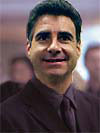Dropped Letters (The Un-filled Die)
Posted on 3/1/2006
 It is a normal occurrence in the process of minting coins that, over time, some part of the dies may become either partially or fully clogged with debris. The most common form of this debris is a combination of metallic fillings and grease or oil which I will call "metallic dirt." (PHOTO #1) Metallic dirt will become imbedded in the recesses of the dies resulting in a coin struck with incomplete detail, missing portions of the design elements. (PHOTO #2) Because of the speed at which the presses operate (at 750 coins per minute), many coins can be struck with this obstruction before this situation is corrected. At some point, an inspector will notice the filled die flaw, stop the presses, and remove the build up. (PHOTO #3)
It is a normal occurrence in the process of minting coins that, over time, some part of the dies may become either partially or fully clogged with debris. The most common form of this debris is a combination of metallic fillings and grease or oil which I will call "metallic dirt." (PHOTO #1) Metallic dirt will become imbedded in the recesses of the dies resulting in a coin struck with incomplete detail, missing portions of the design elements. (PHOTO #2) Because of the speed at which the presses operate (at 750 coins per minute), many coins can be struck with this obstruction before this situation is corrected. At some point, an inspector will notice the filled die flaw, stop the presses, and remove the build up. (PHOTO #3)
In some cases, metallic dirt will become dislodged on its own. In rare instances, under just the right conditions, a portion of this metallic dirt will become dislodged and drop onto an incoming planchet. When the planchet is subsequently struck by the dies, the dislodged piece will be struck into the coin. This piece will either stay imbedded in the surface of the coin or fall out. Either way it will leave a "mark" on the coin. This mark will be an incuse replication of part of the design from which it fell.
One of the most spectacular dropped letters that I have seen is the 1976-D Half Dollar photographed here. (PHOTO #3) Only one letter, the "D" in INDEPENDENCE, became unclogged. The other letters, "EN E" surrounding the "D," show little detail because the die is still partially clogged or filled with metallic dirt. (PHOTO #4) Note that on this example, the metallic dirt has fallen out leaving an incuse and inverted image of the letter ("D"). The dropped letter "D" may seem a little larger than the original "D" above it because the metallic dirt was flattened during striking. (PHOTO #5)
 |
 |
 |
| PHOTO 1 Metallic dirt shown embedded into a coin's surface. All photos by David J. Camire. Click image for enlargement |
PHOTO 2 2004 Handshake 5C, struck from a filled die. Click image for enlargement |
PHOTO 3 A mint employee cleans a die in a coinage press. Click image for enlargement |
 |
||
| PHOTO
4 1976-D Bicentennial 50C with dropped letter below INDEPENDENCE. Click image for enlargement |
PHOTO 5 A close-up image of the 1976-D 50C shown in PHOTO #4. Click image for enlargement |
Stay Informed
Want news like this delivered to your inbox once a month? Subscribe to the free NGC eNewsletter today!

